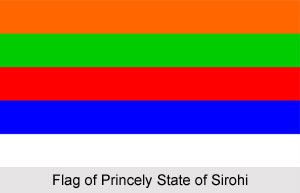 The Princely State of Sirohi was one of the most prominent states during the rule of the British Empire in India. The town of Shivpuri, situated on the west slope of Siranwa Hill was founded in the year 1405 by Rao Sobhaji, but at present the town lies in ruins. Later in 1425, Sehastramal, also known as Sahastramal, his son and successor, founded a citadel on the east slope of the Siranwa hill. This region was later formed as his capital and was developed in the present town of Sirohi. The princely state of Sirohi used to issue its own currency, coins and postage stamp, which are now considered as rare items.
The Princely State of Sirohi was one of the most prominent states during the rule of the British Empire in India. The town of Shivpuri, situated on the west slope of Siranwa Hill was founded in the year 1405 by Rao Sobhaji, but at present the town lies in ruins. Later in 1425, Sehastramal, also known as Sahastramal, his son and successor, founded a citadel on the east slope of the Siranwa hill. This region was later formed as his capital and was developed in the present town of Sirohi. The princely state of Sirohi used to issue its own currency, coins and postage stamp, which are now considered as rare items.
In the early 19th century, Sirohi state endured severely due to the conflict with Jodhpur, as well as the tribes of the Meena hill, located in the area. In the year 1817, the state requested the protection and support of the British East India Company. The pretensions of Jodhpur to dominance through legal authority over Sirohi were prohibited, and later in 1823 a treaty was formed with the British government of India. Eventually the territory of Sirohi was developed as one of the princely states of India under the indirect rule of the British administration. It was also included as a part of the Rajputana Agency.
The Rao or the ruler of the princely state of Sirohi provided aid, military support and other services to the British government during the Great Revolt of 1857. The monarch of the state was given a remission of half his tribute for the services rendered. During the 19th century, the princely state the Rajputana Railway traversed and navigated the princely state. A railway station was developed and constructed at Abu Road, which was located 28 miles south of the town of Sirohi. Rao Keshri Singh ruled over the territory of Sirohi from the year 1875 to 1920. He and his successors were granted with the style and title of Maharao, meaning ruler, in 1889.
According to the Census of India, the total population of the town of Sirohi was 5651. The primary occupation of the people of the princely state was the manufacture of sword blades and other weapons. Sir Robert Crosthwaite established the Crosthwaite Hospital in the region in December 1897.



















